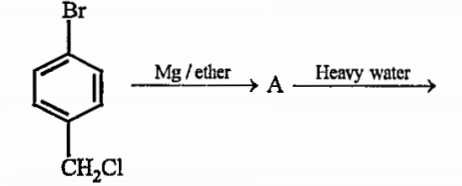Acetic acid is treateed with Ca(OH)2 and the product so obtained is subjected to dry distillation. The final products is
propanal
ethanol
ethanal
propanal
The correct Answer is:D
To solve the problem, let's break it down step by step:
Step 1: Reaction of Acetic Acid with Calcium Hydroxide
Acetic acid (CH₃COOH) reacts with calcium hydroxide (Ca(OH)₂) in a neutralization reaction to form calcium acetate (CH₃COO)₂Ca. This is a typical acid-base reaction where the acid reacts with the base to form a salt and water.
Chemical Equation:
CH3COOH+Ca(OH)2→(CH3COO)2Ca+H2O
Step 2: Dry Distillation of Calcium Acetate
The calcium acetate formed is then subjected to dry distillation. During dry distillation, calcium acetate decomposes to produce acetone (CH₃COCH₃), calcium oxide (CaO), and carbon dioxide (CO₂).
Chemical Equation:
(CH3COO)2CaDry Distillation−−−−−−−−−→CaO+CO2+CH3COCH3
Step 3: Identify the Final Products
From the dry distillation of calcium acetate, the products formed are:
- Calcium oxide (CaO)
- Carbon dioxide (CO₂)
- Acetone (CH₃COCH₃)
Thus, the final products of the reaction are acetone, calcium oxide, and carbon dioxide.
Final Answer:
The final products obtained from the dry distillation of acetic acid treated with calcium hydroxide are acetone (CH₃COCH₃), calcium oxide (CaO), and carbon dioxide (CO₂).
---
Acetic acid (CH₃COOH) reacts with calcium hydroxide (Ca(OH)₂) in a neutralization reaction to form calcium acetate (CH₃COO)₂Ca. This is a typical acid-base reaction where the acid reacts with the base to form a salt and water.
CH3COOH+Ca(OH)2→(CH3COO)2Ca+H2O
The calcium acetate formed is then subjected to dry distillation. During dry distillation, calcium acetate decomposes to produce acetone (CH₃COCH₃), calcium oxide (CaO), and carbon dioxide (CO₂).
(CH3COO)2CaDry Distillation−−−−−−−−−→CaO+CO2+CH3COCH3
From the dry distillation of calcium acetate, the products formed are:
- Calcium oxide (CaO)
- Carbon dioxide (CO₂)
- Acetone (CH₃COCH₃)
The final products obtained from the dry distillation of acetic acid treated with calcium hydroxide are acetone (CH₃COCH₃), calcium oxide (CaO), and carbon dioxide (CO₂).
Topper's Solved these Questions
- ALDEHYDES, KETONES AND CARBOXYLIC ACIDS BOOK - PRADEEPCHAPTER - ALDEHYDES, KETONES AND CARBOXYLIC ACIDS EXERCISE - COMPETITION FOCUS JEE (MAIN AND ADVANCED)/MEDICAL ENTRANCE SPECIEAL (MULTIPLE CHOICE QUESTIONS-II WITH ONE OR MORE THAN ONE CORRECT ANSWER)
1 Videos
- ALDEHYDES, KETONES AND CARBOXYLIC ACIDS BOOK - PRADEEPCHAPTER - ALDEHYDES, KETONES AND CARBOXYLIC ACIDS EXERCISE - COMPETITION FOCUS JEE (MAIN AND ADVANCED)/MEDICAL ENTRANCE SPECIEAL (MULTIPLE CHOICE QUESTIONS-II WITH ONE CORRECT ANSWER)
12 Videos
- ALDEHYDES, KETONES AND CARBOXYLIC ACIDS BOOK - PRADEEPCHAPTER - ALDEHYDES, KETONES AND CARBOXYLIC ACIDS EXERCISE - VALUE BASED QUESTIONS WITH ANSWERS
3 Videos
- ALCOHOLS, PHENOLS AND ETHERSBOOK - PRADEEPCHAPTER - ALCOHOLS, PHENOLS AND ETHERSEXERCISE - IMPORTANT QUESTIONS FOR BOARD EXAMINATIONS.
29 Videos
- APPENDIXBOOK - PRADEEPCHAPTER - APPENDIXEXERCISE - MODEL TEST PAPER <br> (Section C )
15 Videos
Similar Questions
Knowledge Check
Acetic acid is treated with Ca(OH)2 and the product so obtained is subjected to dry distillation. The final product is
APropanoneBPropanalCEthanalDEthanoic acidwhich of the following procucts is formade when benzaldehuyde is treated with CH3MgBr and the addition product so obtained is subjected to acid hydrolysis?
AA secondary alcoholBA primary alcoholCphenolDtert-Butyl alcoholBenzoic acid reacts with Ca(OH)2. The product obtained on dry distilation gives-
ABenzophenoneBAcetophenoneCBenzaldehydeDNone of these
Acetanilide is subjected to nitration and the product formed is subjected to hydrolysis. The resulting final product is mainly
View SolutionThe final product B obtained in the reaction is:

View SolutionAcetone is treated with hydroxylamine and the derivative so formed is subjected to catalytic hydrogenation. Final product is
View SolutionWhen calcium acetate and calcium formate together is subjected to dry distillation , the product is
View SolutionThe final product obtained in the reaction

View Solution

